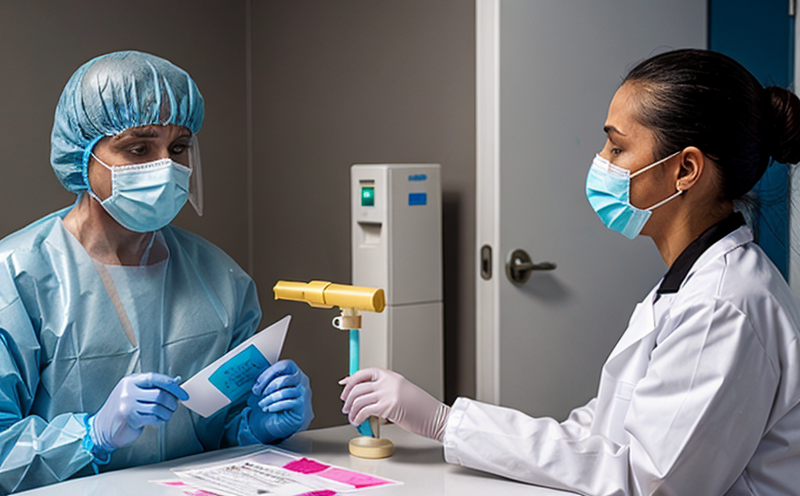Salmonella Detection Testing in Food Products
In today's increasingly complex and interconnected global food supply chain, ensuring the safety of food products is paramount. Salmonella detection testing plays a critical role in safeguarding public health by identifying potential contaminants early in the production process. This service is essential for maintaining compliance with international standards such as ISO 16865:2007 and EU regulations on microbiological criteria for foodstuffs.
Salmonella are Gram-negative bacteria that can cause severe gastrointestinal illnesses, including typhoid fever, gastroenteritis, and other forms of enteric fever. The presence of Salmonella in food products poses significant risks to consumers, especially those with weakened immune systems. Consequently, the testing process must be rigorous, accurate, and timely.
The first step in Salmonella detection is proper sample collection from various parts of the production line, including raw materials, intermediate products, and final packaged goods. Samples are then prepared using appropriate techniques to ensure they are free from contaminants that could interfere with test results. This may involve dilution or enrichment processes depending on the matrix being tested.
Once samples have been adequately prepared, they undergo microbiological analysis using culture-based methods like the most probable number (MPN) technique or molecular detection approaches such as polymerase chain reaction (PCR). Culture-based methods rely heavily on incubation periods during which Salmonella colonies grow under specific conditions. These include temperature ranges between 35°C and 37°C, depending on the strain being targeted.
For more rapid results, PCR technology offers an alternative approach by amplifying DNA sequences unique to Salmonella species without requiring extensive incubation times. However, both methods must adhere strictly to predefined acceptance criteria outlined in relevant standards like ISO 16865:2007 and EU legislation.
Following the completion of either method, positive samples are further characterized through serotyping or genotyping analyses to determine their exact strain identity. This information is crucial for tracing outbreaks back to their sources and implementing targeted control measures within the supply chain.
The significance of accurate Salmonella detection extends beyond mere regulatory compliance; it also contributes significantly towards enhancing brand reputation among consumers who increasingly prioritize food safety when making purchasing decisions. By proactively identifying and addressing contamination issues early on, companies can prevent costly recalls while simultaneously fostering trust with their customers.
Why It Matters
The importance of Salmonella detection testing cannot be overstated given its direct impact on public health. According to the World Health Organization (WHO), Salmonellosis remains one of the most common foodborne illnesses globally, affecting millions annually and leading to hospitalizations in severe cases.
From a business perspective, failing to detect and address Salmonella contamination could result in product recalls, fines from regulatory bodies, loss of consumer confidence, and potential legal action. Moreover, these incidents often lead to increased operational costs due to heightened scrutiny during audits or inspections by health authorities.
Implementing robust testing protocols not only mitigates these risks but also demonstrates a commitment to quality assurance that resonates positively with stakeholders across the supply chain – from suppliers and manufacturers to retailers and consumers alike. In an era where transparency is key, having reliable test results available promptly allows companies to respond swiftly to any emerging threats, thereby protecting both their reputation and bottom line.
Customer Impact and Satisfaction
Customers today expect not only safe but also high-quality food products. By offering comprehensive Salmonella detection testing services, laboratories help ensure that each batch of food meets stringent safety standards. This contributes directly to improved customer satisfaction levels as consumers feel reassured about the quality and purity of what they consume.
Moreover, consistent compliance with recognized international standards such as ISO 16865:2007 helps build long-term relationships based on mutual trust between suppliers and distributors. When buyers know that every step in the production process has been meticulously monitored for potential contaminants like Salmonella, they are more likely to choose products from reputable sources.
For internal stakeholders such as quality managers and R&D engineers, having access to precise data regarding microbial presence within food items enables informed decision-making processes. This includes optimizing processing techniques or adjusting ingredient sourcing strategies aimed at reducing the risk of contamination further down the line.
Competitive Advantage and Market Impact
In today's competitive market, differentiation through superior quality assurance measures can provide a significant edge. Companies that invest in advanced Salmonella detection technologies not only meet but exceed industry expectations regarding food safety. This proactive approach fosters loyalty among existing customers while attracting new business opportunities from discerning buyers who prioritize health and wellness.
From an operational standpoint, efficient testing methods reduce downtime associated with halted production lines due to suspected contamination issues. Faster turnaround times mean quicker resolution of any problems identified, allowing businesses to maintain continuous operations without disruption.
The ability to provide accurate reports promptly also enhances overall efficiency within the supply chain by facilitating smoother transitions between different stages of processing or distribution. Such streamlined processes contribute positively toward meeting delivery deadlines and enhancing customer experience throughout the entire transaction cycle.





